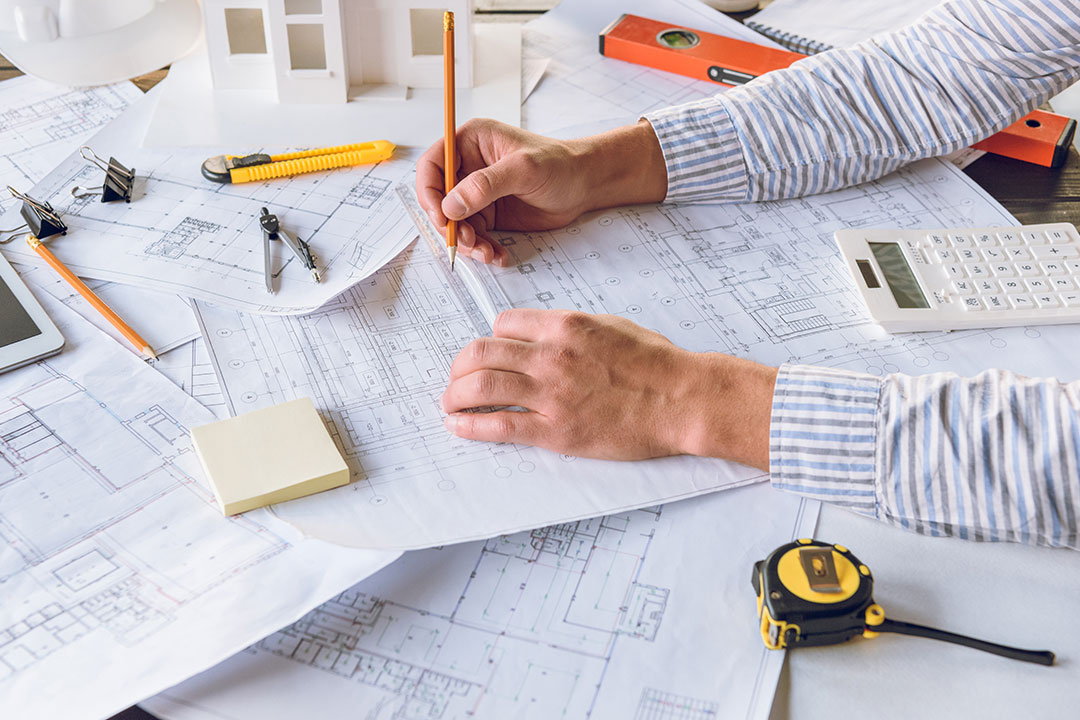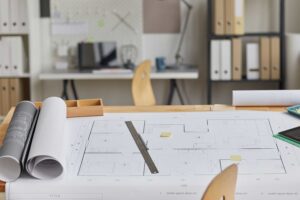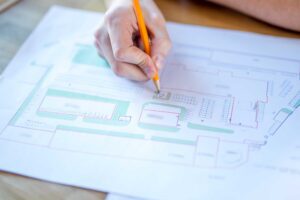As architects and planning practice, DMS understands the numerous complexities that can arise within the planning application process.
Put simply, planning applications form an indispensable part of any building project, whether it’s a compact residential renovation or a large commercial development.
A successful application becomes the green light that propels your dream project from paper to reality.
But how do they work, and why are they so important?
Sit back as we explain everything you need to know about planning applications.
What Are Planning Applications?
Planning applications are formal requests submitted to your local planning authority seeking approval to carry out development. Whether it’s about building a new structure, making changes to an existing one, or changing the use of buildings or land, a planning application is an essential stage of any project.
Planning applications typically include existing and proposed design plans, a site location and block plan, and a completed application form, amongst other necessary documents – such as a design and access statement, and external consultant reports covering matters such as heritage, ecology, trees, and highways.
These are all intended to thoroughly understand the proposed development’s impact on its surroundings.
These applications aim to ensure the harmony of local development with environmental considerations as well as economic and societal needs. This process allows for an evaluation of how the proposed project might affect its surroundings and, critically, its accordance with local and national planning policies.
It’s not uncommon for homeowners to feel daunted by the idea of putting together planning applications, which is where DMS Architects can step in.
We will work with you to ensure that what can be a seemingly complicated process becomes a seamless experience. Armed with our in-depth knowledge, we can foresee potential issues, suggest alternatives, and increase the chances of first-time planning approval, saving you time, money, and resources.
Why Do You Need a Planning Application?
The necessity of planning applications might seem like an additional hurdle in your building project’s journey; however, they serve an essential purpose. Failing to initiate one when required can lead to complications, including legal issues and delays. Here are key reasons why planning applications are vital:
- Legal Requirement: For most building endeavours, planning permission is a legal necessity. It’s often the first step in an architectural project. The lack of one when required could mean having to undo the work done, which could be both stressful and costly, or even result in prosecution.
- Understanding Viability: Planning applications evaluate the practicality of your proposed project. They provide a framework to gauge whether your dream project is acceptable in terms of design, size, impact on neighbouring properties, and compliance with local planning policies, alongside any other ‘material’ considerations.
- Avoiding Future Problems: Throughout the planning application process, all potential issues should come to light. These could relate to your legal rights, the local development plan, building height restrictions, or other site-related obstacles. A planning application helps identify and address potential problems before they arise, saving you from mid-project surprises.
- Protecting the Environment: Planning authorities take a holistic view when reviewing applications to ensure the proposed works don’t adversely affect the local environment or protected sites, ensuring a sustainable approach to development.
- Enhancing Value: An approved planning application often adds value to your property or development, especially if your project involves adding usable space or improving the aesthetic appeal of your home or land the buildings are part of.
Considering the complexities involved, having an experienced architect is invaluable. DMS Architects can guide you through the process, helping to enhance your proposal while ensuring it complies with planning guidelines, increasing the chances of early-stage approval and saving potential rework costs.
Our insight into planning policies and knack for design make navigating the planning application process smoother.
How Do You Submit a Planning Application?
Submitting a planning application requires time, effort, and expertise. Here’s an overview of how the process unfolds when DMS Architects takes charge:
- Consolidating Required Information: We begin by gathering all the crucial details about your proposed project, such as the design specifics, the site’s context, and the potential impact on neighbours. Our team prepares detailed plans and documents that comply with your local planning authority’s requirements.
- Pre-Planning Application: The pre-planning application is a pivotal early step in an architectural project. The aim here is to explore, identify, and understand the local authority’s view on the project’s likelihood of success, as well as the potential challenges it faces. We provide clients with advice on design, the likelihood of achieving planning permission, and guidance on the type of application and consultant reports required.
- Application Preparation: The next step is preparing the planning application itself. This includes completing necessary forms, creating precise architectural drawings, and collecting relevant supporting documentation. Our wealth of experience allows us to carefully curate this package, clearly conveying your vision and ensuring it aligns with planning policies. This significantly increases the chances of a successful application.
- Liaising with the Local Planning Authority: After submission, there is often back-and-forth communication with the planning authority. We manage these interactions on your behalf, addressing queries and providing additional details if needed. This process may involve negotiation or design alterations. Our team ensures that your project’s essence remains intact while maximising the likelihood of approval.
- Planning Decision: After careful consideration, the planning authority makes a decision. Minor applications typically take about 8 weeks, while major applications (like new housing estates) can take up to 13 weeks. If the decision is unfavourable, you can appeal or amend your proposal based on feedback. DMS Architects will guide you through whichever route you choose.
What Do You Do if a Planning Application Is Refused?
Receiving a refusal for a planning application can feel disheartening, but it’s important to remember that it’s not the end of the road for your project. Each refusal comes with a detailed reason for the decision, providing valuable insights for revising and strengthening your application.
At DMS Architects, we often know when a refusal is coming and will have advised on the potential changes needed to make the scheme more acceptable.
Sometimes we will withdraw an application before a refusal comes through, so we can make significant changes before resubmitting it.
Here’s how DMS Architects will guide you through the process in the event of a planning application refusal:
- Understand the Reason(s) for Refusal: The reasons for refusal act as guidelines for amendment or appeal. Our first step is to thoroughly review these reasons, determining whether the issues were related to policy, design, or other concerns.
- Modify the Design: Based on the reasons for refusal, we will revise the plan to address the local authority’s concerns. As expert architects, we’ll ensure that the modifications align with your initial vision while complying with the authority’s recommendations.
- Resubmit the Application: After making the necessary design modifications, we can resubmit the application. Previously, resubmissions within 12 months were free of charge, but this has changed. We use the pre-application process to identify what the council finds acceptable before formally submitting, although refusals can still occur. Our aim is to adequately address refusal reasons to secure approval on the next attempt.
- Appeal the Decision: If a revised application is not viable or desirable, you have the right to appeal the decision. The appeal is made to the Planning Inspectorate, and as your planning permission architect, we will guide you through the process, prepare the necessary documentation, and present your case strongly.
We understand that setbacks are part of the journey. A refusal can be disheartening, but it’s not always the end. With our experience and determination, we can turn these obstacles into stepping stones toward obtaining the planning permission you need for your project.











